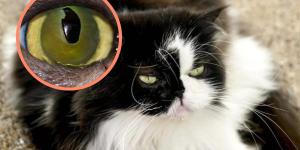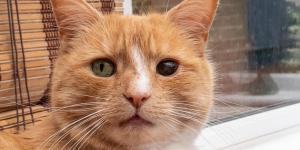Cat's Eye Corneal Ulcer - Causes and Treatment



See files for Cats
Our cat's eyes can be very sensitive. Even small irritations can lead to serious consequences, especially if left untreated. Corneal ulcers are just one of the serious eye problems which can effect cats. Others include uveitis, cataracts and hyphema. Not all corneal ulcers are the same. Superficial corneal ulcers are often more painful as they affect the more sensitive epithelium. Ulcers affecting the inner layers of the cornea are more serious as they increase the risk of perforation of the eyeball. This can lead to very serious consequences, including blindness.
You can learn more about corneal ulcers in cat eyes with AnimalWised. We look at the different types of corneal ulcers which can affect felines, as well as their causes, symptoms and treatment.
Types of eye ulcers in cats
Ulcers in the eyes of cats occur in the cornea. They are essentially inflammation or other types of damage affecting the surface of the cornea. This condition can be very painful and is complicated when the underlying cause is infectious. The cornea itself is a thin, transparent and avascular (without blood vessels) anterior part of the eyeball. Its main function is to refract and transmit light to the retina, as well as protect other parts of the eye.
The cornea is made up of four parts. From the outermost layer to the innermost, they are as follows:
- Corneal epithelium
- Corneal stroma
- Descemet's membrane
- Corneal endothelium
Depending on the depth of the damage caused to the cornea, corneal ulcers in cats can be of the following types:
- Superficial corneal ulcers: those with erosion that has occurred in the corneal epithelium. They should resolve in a few days on their own if there are no further complications.
- Stromal corneal ulcers: when the erosion affects the corneal stroma, in addition to the epithelium. In turn, they can be classified into anterior, middle and posterior stromal ulcers, the latter two being more serious and profound.
- Descemetic corneal ulcers: when the erosion has reached Descemet's membrane, so that only the endothelium protects the eye from perforation. They are an ophthalmological emergency and the solution is surgery.
- Perforated corneal ulcers: when all the layers of the cornea have been damaged, a perforated ulcer is produced in the cat's eye. The perforation of the eyeball develops with a corresponding exit of the aqueous humor from its interior.
When we look into a cat's eye if they have a corneal ulcer, we will see that part of the eye looks cloudy. This is the ulcer itself, but there are other reasons white spots appear on a cat's eye. Take a look at our article on why a cat has a cloudy eye to learn more.
Causes of eye ulcers in cats
The epithelium of the cornea continuously regenerates due to phenomena such as blinking and drying of the eye. The protection mechanisms of the cornea should be sufficient to prevent physical damage, something which can lead to a corneal ulcer. There are other reasons corner ulcers in cats can develop. Some of these are primary and others are secondary to the underlying cause:
Corneal ulcer in cats can be produced by causes as varied as the following:
- Trauma (e.g. blows, falls, introduction of foreign bodies)
- Self-trauma (scratching)
- Chemical irritation
- eye dryness
- Viral (feline herpesvirus type-1), bacterial or fungal infections
- Conjunctivitis
- Genetic causes
- Entropion (eyelid folding into the eye)
- Ectropion (eyelid folding outward)
- Trichiasis (backward-growth of eyelashes)
- Distichiasis (abnormal growth of eyelashes)
- Neoplasms
- Ectopic cilia
- Tear deficiencies
Symptoms of eye ulcers in cats
Corneal ulcers in cats are extremely painful, especially the superficial ones as they affect the most sensitive part. In addition to this pain and discomfort, cats develop other clinical signs which may suggest they have developed a corneal ulcer. In addition to obvious pain and discomfort, cats may develop clinical signs such as the following:
- Squinting of the eyes
- Overproduction of tears
- Thick mucous discharge
- Swelling
- Redness
- Photosensitivity
- Conjunctivitis
- Blepharospasm (uncontrollable blinking)
- Corneal edema
While superficial corneal ulcers are more painful, deeper ulcers are more dangerous because there is a risk of perforation of the eyeball. Treatment is more complicated the further the ulcer penetrates and usually requires surgery.
Corneal ulcers are not the only eye problems in cats. Take a look at our article on why a cat's eyes are swollen and red to learn more.

How to cure an ulcer in the cat's eye?
The treatment of corneal ulcers in cats will depend on their severity (superficial or deep) and the underlying cause. For example, if the cause is an infection, specific antiviral, antibiotic or antifungal treatment should be given. If the problem is due to an ocular issues such as entropion or trichiasis, then the eye will need to be moistened with drops to manage symptoms. Surgery will likely need to be carried out to resolve the problem manually.
Superficial ulcers usually respond well to medicated eye-drops and pain-contorl medication. These may include topical atropine to dilate the pupil and control painful ciliary muscle spasm in cats with secondary uveitis. Deeper ulcers may require grafting of biomaterials or surgical techniques such as corneoconjunctival transposition (where healthy corneal tissue is used to support toe ulcerated area) or lamellar keratoplasty (donated corneal tissue is grafted to the ulcerated area).
How long does it take for a corneal ulcer in cats to heal?
The recovery time of the corneal ulcer in the cat will depend on the severity and the type of treatment performed. If you think your cat's eye ulcer isn't healing and you haven't been to the vet, you should go as soon as possible. Corneal ulcers can cause complications that can be irreversible and seriously affect your cat's eye health and may even cause blindness if not treated sufficiently.
To help prevent any damage to a cat's eye and ensure their ocular health, we will need to do what we can to prevent eye problems such as corneal ulcers. Some cat breeds are more likely to develop eye problems than others, especially brachycephalic breeds. Although cats groom themselves regularly, we need to ensure we keep the animal's eyes clean at all times. You can see how to do this safely with our guide to cleaning a cat's eyes.
This article is purely informative. AnimalWised does not have the authority to prescribe any veterinary treatment or create a diagnosis. We invite you to take your pet to the veterinarian if they are suffering from any condition or pain.
If you want to read similar articles to Cat's Eye Corneal Ulcer - Causes and Treatment, we recommend you visit our Eye problems category.
- Turner, S. M. (2010). Small Animal Ophthalmology. Elsevier Spain SL






